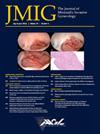When in Doubt, Green It Out: Use of ICG in the Hysteroscopic-Assisted Robotic Excision of an Isthmocele in a Patient With Asherman's Syndrome
IF 3.5
2区 医学
Q1 OBSTETRICS & GYNECOLOGY
引用次数: 0
Abstract
Study Objective
To demonstrate the utility of indocyanine green (ICG) as an intraoperative aid in the hysteroscopic-assisted robotic repair of isthmocele in a patient with Asherman's syndrome.
Design
Video case review.
Setting
Procedure was performed by a MIGS fellowship-trained surgeon at a community-based hospital.
Patients or Participants
A 43-year-old G7P5032 referral from OBGYN with history of prior endometrial ablation diagnosed with an isthmocele on TVUS in the setting of cyclic postmenstrual bleeding.
Interventions
Use of ICG during a hysteroscopic-assisted robotic repair of an isthmocele.
Measurements and Main Results
ICG was utilized to enhance visualization of the isthmocele when hysteroscopic transillumination and visual palpatory cues are difficult to appreciate due to abnormal uterine anatomy such as Asherman's Syndrome. Two months follow up saline-infused sonography demonstrated significant improvement in residual myometrial thickness (RMT) and lack of fluid collection at site of previously noted isthmocele defect. Patient's post operative course was uncomplicated with complete resolution of symptoms.
Conclusion
ICG is a valuable tool for identifying an isthmocele defect in complex surgical cases where scarring and adhesions obscure normal uterine anatomy and landmarks. Use of ICG is safe and can improve surgical accuracy and outcomes in the management of an isthmocele, particularly in patients with prior uterine surgeries and altered anatomical structures. This technique warrants further investigation in larger prospective studies to assess its impact in patient outcomes.
当有疑问时,将它 "绿 "出来:在宫腔镜辅助机器人切除阿什曼氏综合征患者膀胱峡部时使用 ICG
研究目的 展示吲哚菁绿(ICG)作为术中辅助工具在阿什曼氏综合征患者宫腔镜辅助机器人峡部修复术中的应用。患者或参与者一名 43 岁的 G7P5032 妇产科转诊患者,既往有子宫内膜消融史,经 TVUS 诊断为峡部畸形,并伴有周期性经后出血。干预措施在宫腔镜辅助机器人修复峡部肌瘤时使用ICG。测量和主要结果当宫腔镜透照和视觉触诊线索因异常子宫解剖结构(如阿舍曼氏综合征)而难以观察峡部肌瘤时,使用ICG增强峡部肌瘤的可视性。两个月的盐水超声随访显示,残余子宫肌厚度(RMT)明显改善,之前发现的峡部缺损部位也没有积液。结论 ICG 是在瘢痕和粘连掩盖了正常子宫解剖结构和标志的复杂手术病例中识别峡部缺损的重要工具。使用 ICG 是安全的,可以提高手术的准确性并改善峡部畸形的治疗效果,特别是对于曾接受过子宫手术和解剖结构改变的患者。这项技术值得在更大规模的前瞻性研究中进一步探讨,以评估其对患者预后的影响。
本文章由计算机程序翻译,如有差异,请以英文原文为准。
求助全文
约1分钟内获得全文
求助全文
来源期刊
CiteScore
5.00
自引率
7.30%
发文量
272
审稿时长
37 days
期刊介绍:
The Journal of Minimally Invasive Gynecology, formerly titled The Journal of the American Association of Gynecologic Laparoscopists, is an international clinical forum for the exchange and dissemination of ideas, findings and techniques relevant to gynecologic endoscopy and other minimally invasive procedures. The Journal, which presents research, clinical opinions and case reports from the brightest minds in gynecologic surgery, is an authoritative source informing practicing physicians of the latest, cutting-edge developments occurring in this emerging field.

 求助内容:
求助内容: 应助结果提醒方式:
应助结果提醒方式:


